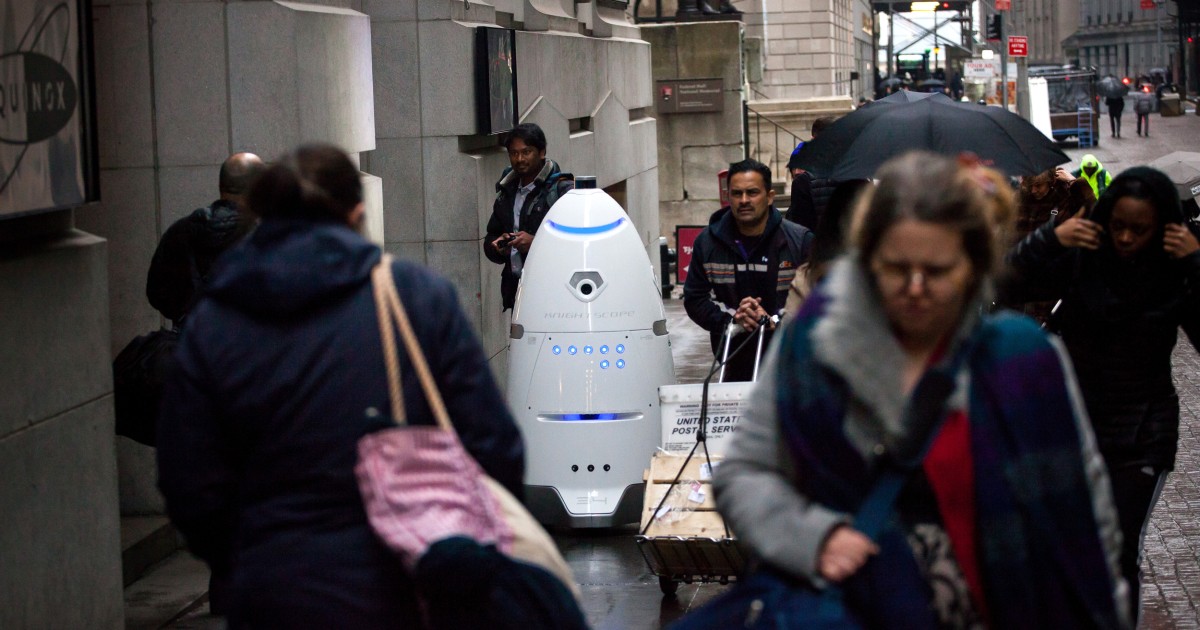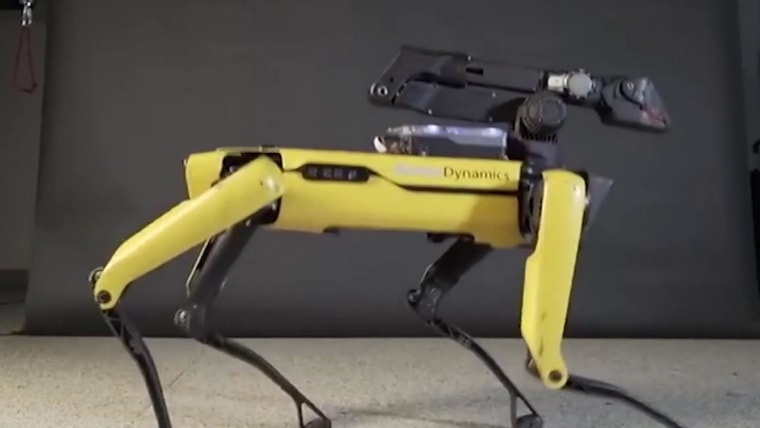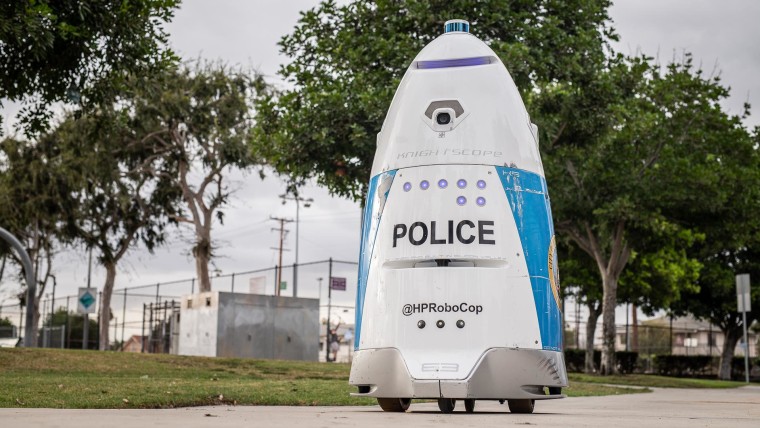Table of Contents
When the Westland Real Estate Group bought Liberty Village, a sprawling 1,000-unit apartment complex on the northeastern edge of Las Vegas nearly two years ago, the police department identified it as one of the city’s most frequent sources of 911 calls.
“There was a little bit of everything,” said Dena Lerner, a spokeswoman for Westland. “A lot of gang activity that revolved around controlled substances, prostitution, dog rings. We had issues with gun rings, drive-by shootings, robberies, assaults — we’re talking everything.”
So earlier this year, Westland introduced a broader program to reduce crime and added an “autonomous security robot” manufactured by Knightscope, a Silicon Valley company to make the complex safer. Each robot is given a nickname, and the one roaming around Liberty Village is called “Westy.”
This model, K5, is a conical, bulky, artificial intelligence-powered robot that stands just over 5 feet tall. Westy slowly roams around at about a human walking speed, with four internal cameras capturing a constant 360-degree view. It also can scan and record license plates and unique digital identifiers that every cellphone broadcasts, known as MAC addresses.
But it’s unclear how much Westy has reduced crime at Liberty Village. Knightscope, which is eagerly trying to recruit new clients, told local news outlets that Westy had resulted in a “significant drop in 911 calls,” underscoring “yet another crime-fighting win.” Knightscope included articles about Westy as part of its recent pitch to individual investors and in its plans to take the company public.
Officer Aden Ocampo-Gomez, a spokesman for the Las Vegas Metropolitan Police Department, said that while the complex is no longer in the agency’s top 10 list for most frequent 911 calls in the northeastern part of the Las Vegas Valley, he doesn’t think all the credit should go to Westy.
“I cannot say it was due to the robot,” he said.
As more government agencies and private sector companies resort to robots to help fight crime, the verdict is out about how effective they are in actually reducing it. Knightscope, which experts say is the dominant player in this market, has cited little public evidence that its robots have reduced crime as the company deploys them everywhere from a Georgia shopping mall to an Arizona development to a Nevada casino. Knightscope’s clients also don’t know how much these security robots help.
“Are we seeing dramatic changes since we deployed the robot in January?” Lerner, the Westland spokesperson said. “No. But I do believe it is a great tool to keep a community as large as this, to keep it safer, to keep it controlled.”
For its part, Knightscope maintains on its website that the robots “predict and prevent crime,” without much evidence that they do so. Experts say this is a bold claim.
“It would be difficult to introduce a single thing and it causes crime to go down,” said Ryan Calo, a law professor at the University of Washington, comparing the Knightscope robots to a “roving scarecrow.”
Additionally, the company does not provide specific, detailed examples of crimes that have been thwarted due to the robots.
“I definitely say that we are making a difference,” said Stacy Stephens, Knightscope’s co-founder and executive vice president. “You don’t know what might have happened compared to deploying a security guard out there.”
Newtown Roots
The company’s CEO, William Li, founded Knightscope after trying to come up with a response to the December 2012 mass shooting at Sandy Hook Elementary School in Connecticut that left 20 young children dead.
“That infuriated me,” Li, a former Ford executive, told USA Today in January 2014.
The company came up with a robot that would “predict and prevent crime in your community,” according to an archived version of its website.
“There are 7 billion people on the planet, and we’ll soon have a few billion more, and law enforcement is not going to scale at the same rate; we literally can’t afford it,” Li said.
Since then Knightscope robots have become the crime-fighting friend of corporate clients in various cities nationwide, including Honolulu, Washington, D.C. and a community college in Tucson, Arizona.
Typically, a casino, residential facility, bank or, in one case, a police department, rents a robot for an average fee of around $70,000 to $80,000 per year. Part of that cost involves Knightscope storing all of the data that robots like Westy gather in a year. This huge volume of data is the equivalent of more than the combined storage of 175 iPhones, each with the maximum storage capacity of 512 gigabytes.
According to Knightscope’s most recent annual report, the company has a current fleet of 52 machines used across 23 clients, with a backlog of 27 more robots to deliver. Each robot has an expected life span of “three to four and a half years.”
Money problems
But the finances behind the police robot business is a difficult one. Last year, Knightscope lost more money than ever, with a $19.3 million net loss, nearly double from 2019. While some clients are buying more robots, the company’s overall number of clients fell to 23, from 30, in the past four years. Plus, the number of robots leased has plateaued at 52 from the end of 2018 through the end of last year. The pandemic certainly didn’t help things.
Just two months ago, Knightscope told investors that there was “substantial doubt regarding our ability to continue” given the company’s “accumulated deficit,” or debt, of over $69 million as of the end of 2020. Its operating expenses jumped by more than 50 percent, including a small increase on research, and a doubling of the company’s marketing budget. Knightscope itself recently told investors that absent additional fundraising efforts, it will “not be solvent after the third quarter of 2022.”
Stephens, Knightscope’s co-founder, said that the company’s client retention rate is 85 percent, and that the company has clients that have renewed for four years.
“I can’t comment on future rounds of funding. But we have been through seven rounds of funding to date,” he said. “We’ve been able to advance the technology each time, and we have been able to grow the revenue side each time as well.”
Limited supervision
Knightscope’s best-known deployment is in Huntington Park, California, a small city south of downtown Los Angeles. The Huntington Park Police Department was the first law enforcement agency to partner directly with Knightscope. For two years, a single Knightscope robot, dubbed “HP RoboCop,” has roamed part of the city’s Salt Lake Park. The robot captures constant video of park activity, and has the ability to broadcast back to police live, although the Huntington Park Police Department does not use this feature often.
As recently as May 2020, the Huntington Park Police Department presented statistics to the City Council comparing a five-month period, from June to December, in 2018 and in 2019. The data shows that “crime or incident reports” went down, from 48 to 26, and arrests went up, from 11 to 14.
“The K-5 robot is having a positive impact on crime and nuisance activity at Salt Lake Park, which is reducing the instances of police activity at the park,” both the city manager, Ricardo Reyes, and the chief of police, Cosme Lozano, wrote to local lawmakers last year. In a recent interview, Lozano called the robot’s presence a “positive result” and sees “no downside” in having it.
But the department does not even use all of the robot’s abilities, according to Lozano.
The police can’t monitor the robot’s live video on a constant basis because that would “burn through” the 100 gigabytes of data that the agency has allotted to it per month, similar to a data cap on a monthly cellphone plan. Lozano added that the Huntington Park Police Department also does not use the license plate reader, thermal scanning or mobile phone scanning features, as they have not been adequately evaluated by the police department yet.
When asked to cite examples of arrests that were made because of the robot over the two years since it was deployed, Lozano said there haven’t been many.
“I want to say that it’s been useful in robot tipping and vandalism against the robot itself,” he said, noting that this has only occurred twice in two years.
Nevertheless, Lozano said he will recommend that the city renew the contract again when it comes before the City Council, which is expected in coming weeks.
Bigger problems
As Knightscope has expanded, it has been involved in both tragic and comical episodes.
In 2016, a K5 roaming around Stanford Shopping Center in Palo Alto, California, hit a 16-month-old toddler, bruising his leg and running over his foot. The company apologized, calling it a “freakish accident,” and invited the family to visit the company’s nearby headquarters in Mountain View, which the family declined. The following year, another K5 robot slipped on steps adjacent to a fountain at the Washington Harbour development in Washington, D.C., falling into the water.
In October 2019, a Huntington Park woman, Cogo Guebara, told NBC News that she tried reporting a fistfight by pressing an emergency alert button on the HP RoboCop itself, but to no avail. She learned later the emergency button was not yet connected to the police department itself.
Knightscope once promoted several clients in California, including the NBA’s Sacramento Kings the city of Hayward, and the Westfield Valley Fair Mall in Santa Clara,not far from the robot company’s headquarters. But those clients say that they no longer have contracts with Knightscope.
Hayward dispatched its robot in a city parking garage in 2018. The following year, a man attacked and knocked over the robot. Despite having clear video and photographic evidence of the alleged crime, no one was arrested, according to Adam Kostrzak, the city’s chief information officer.However, last year, Hayward did not renew the annual contract with Knightscope “due to the financial impact of Covid-19 in early 2020,” Kostrzakemailed. The city spent over $137,000 over two years on the robot.
When asked whether the city had seen any concrete evidence of a crime reduction from the robot, Kostrzak did not provide any.
“It did successfully navigate the garage, technical hiccups were minimal as well as our residents and staff appreciated its presence,” he emailed. “Had the robot contract been renewed, the second step would have been to expand into the [detailed] crime statistics for the area covered by the robot with our Police Department, unfortunately the onset of Covid-19 halted this plan.”
The Huntington Park and Las Vegas robots are the only specific examples named on the company’s website that have allegedly contributed to a reduction in crime. But that’s because Stephens, the company VP, said that nearly all of his company’s clients do not want the details of any crime-related incidents to be made public.
Challenging task
Ultimately, law enforcement and legal experts say that it is difficult for any firm to show that a given piece of technology definitively results in a reduction in crime.
Andrew Ferguson, a law professor at American University, called these robots an “expensive version of security theater,” using a term for procedures that aim to make an environment more secure, but do not always have that demonstrable effect.
“This is an obviously noticeable surveillance device that is meant for you to look and stop and realize that you are under surveillance and that would deter you,” he said. “They are slow, they don’t do anything besides record a lot of data.”
One of the best uses for a robot may be what one community college in Arizona has tried. They’re using the robot as a technological demonstration, and “less of a security tool.”
Libby Howell, a spokeswoman for Pima Community College in Tucson, noted that this model does not use the facial recognition feature, because that had raised concerns among faculty and students, many of whom are Dreamers, or immigrants brought to the United States as young children, who conceivably could be deported.
“It’s not trying to solve a problem,” Howell said. “It’s trying to show students that technology is changing by leaps and bounds every day, and what you are majoring in today could have application tomorrow.”
But Knightscope’s users remain hopeful that these police robots will make a difference.
Robert Krauss, the vice president of public safety at the Pechanga Resort Casino, about an hour’s drive north of San Diego, said that in the past three years the casino has used one robot to roam the casino floor and five robots to stand next to human security at the casino’s main entrances.
He doesn’t know how useful they have been in terms of stopping crime, but said that the robots have been able to identify panhandlers and other people that the casino wants to exclude. Once, video from a robot even staved off a potential slip-and-fall civil lawsuit by providing clear-cut footage of a woman who fell and claimed the casino was at fault.
“You never know how many [bad actors] you’ve prevented by placing [the robots] there, so I don’t know what we’ve prevented. But I can tell you we’ve never had anything serious,” Krauss said, noting that many customers just like taking pictures with them.
“Going forward, I will probably add one or two more.”






